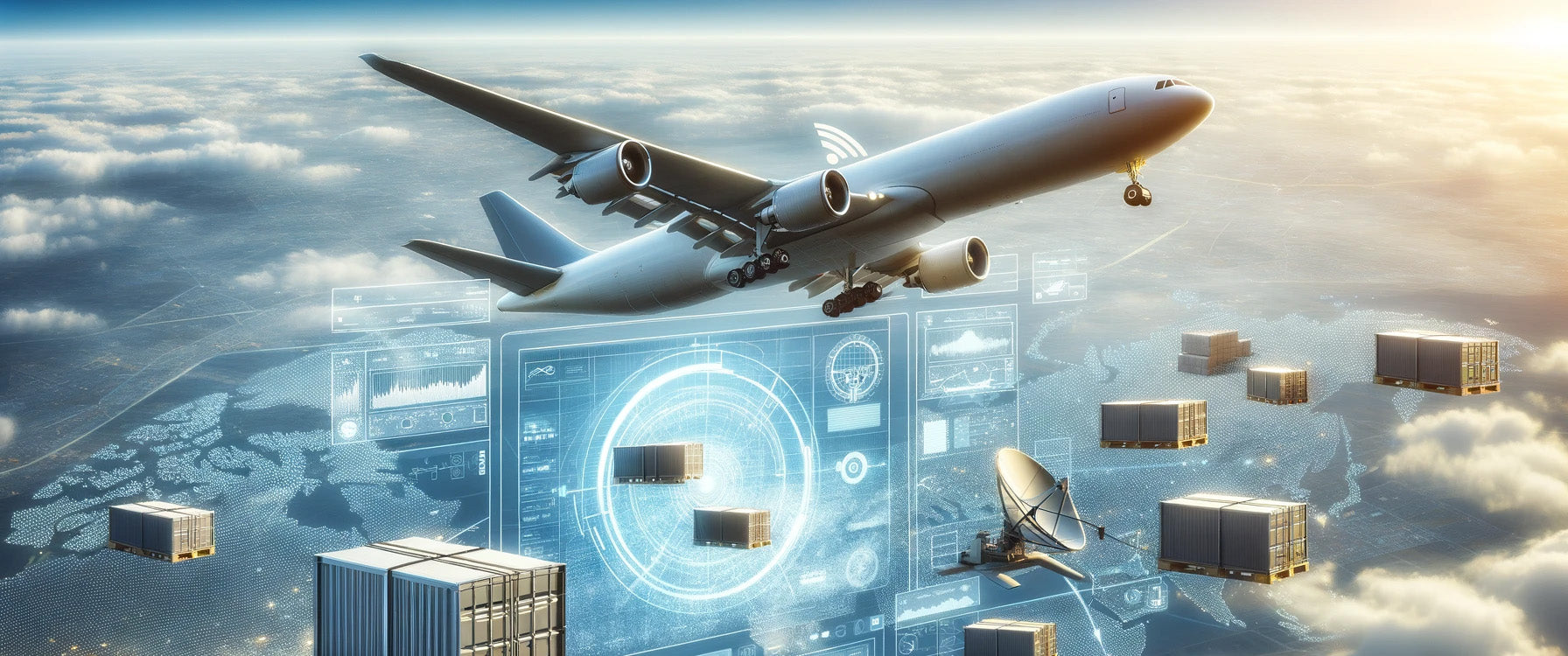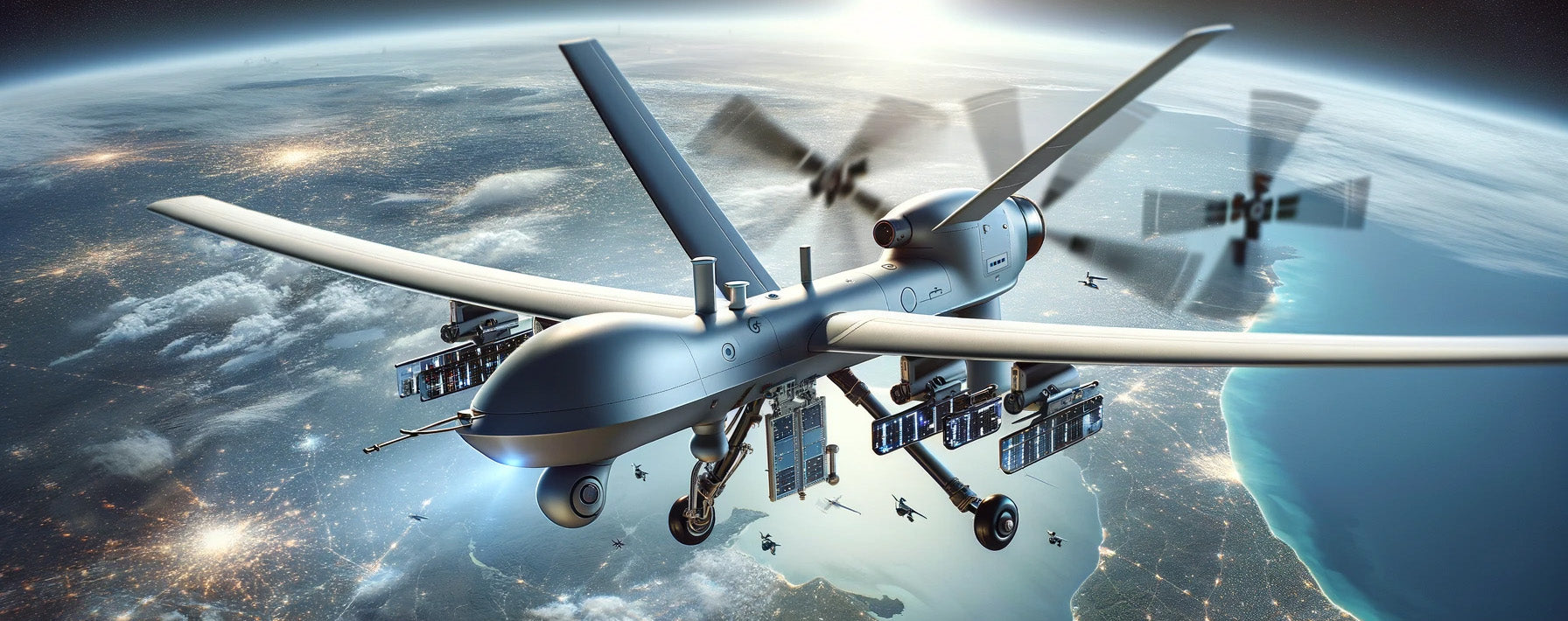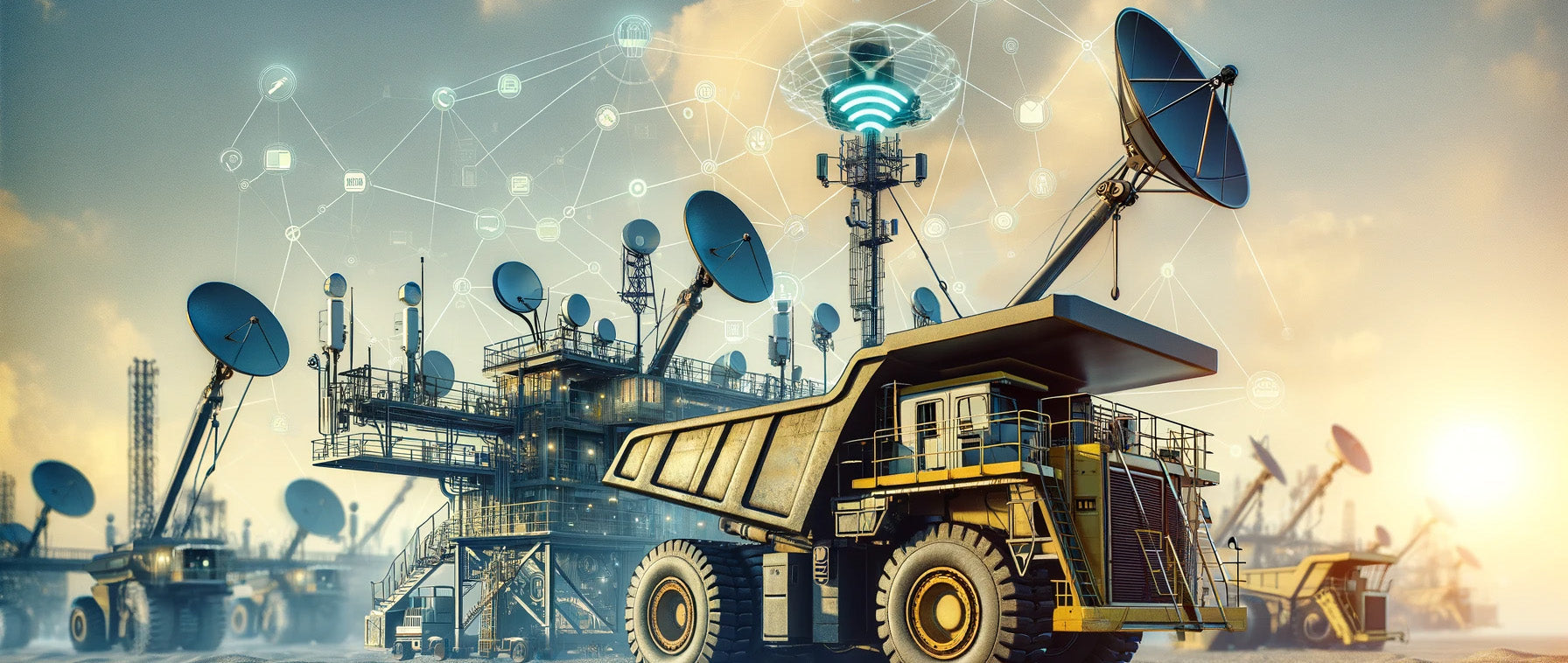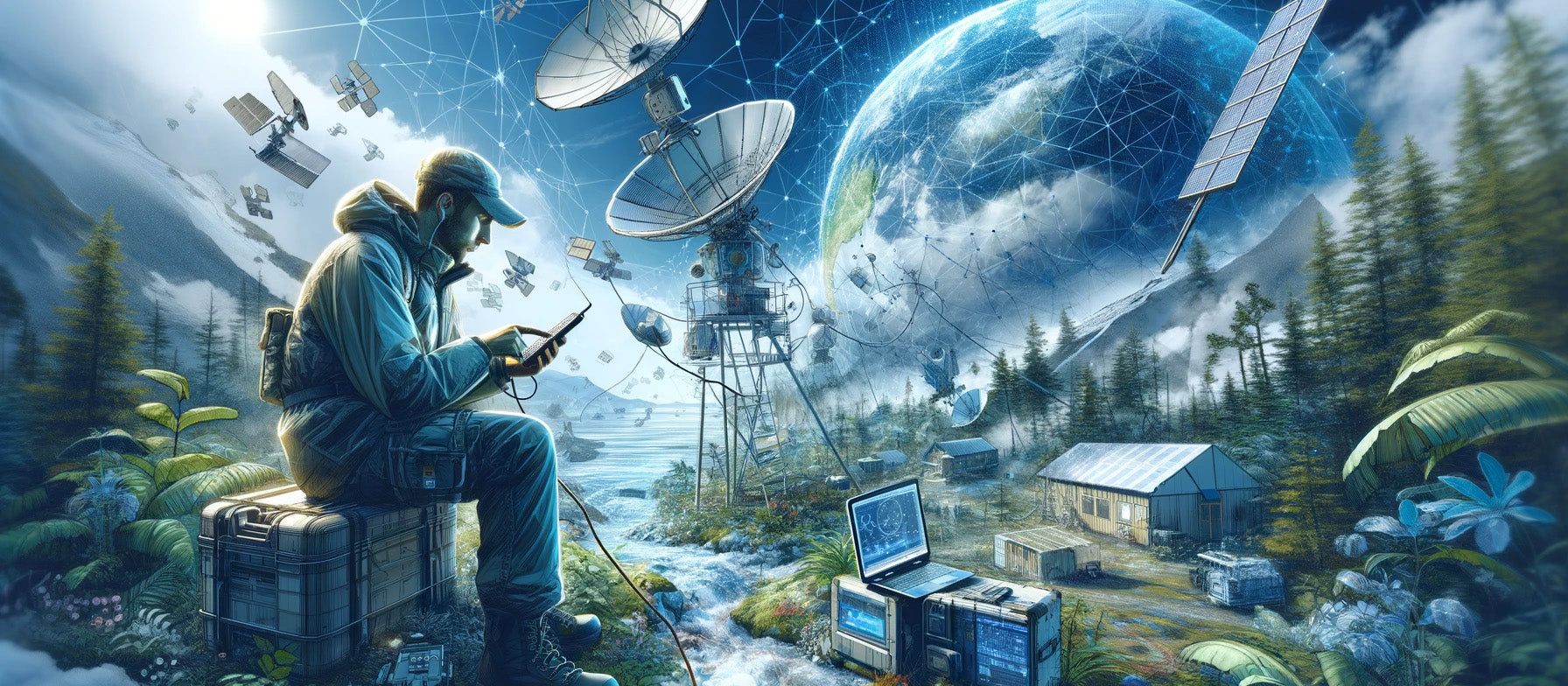
How Satellite Networks Are Revolutionizing Remote Area Communications
- 23 Feb, 2024
- Posted by: Michael Mathison
Satellite Networks and Remote Area Communications
Satellite networks are at the forefront of transforming communication in remote areas, offering a lifeline where traditional connectivity methods fall short. This revolutionary technology ensures that individuals and businesses in the most isolated parts of the world can now stay connected to the global network.
By leveraging the vast coverage and reliability of satellite networks, we're witnessing a paradigm shift in how information is exchanged, fostering inclusivity, and driving economic growth in regions once considered off the grid. This introduction to satellite communications explores how this technology is bridging the digital divide, enabling progress and resilience in remote communities worldwide.

Personal Communications
Satellite networks are fundamentally transforming personal communications, especially in remote areas that have historically been cut off from the rest of the world due to geographical challenges and the absence of traditional telecommunications infrastructure. Here's how these networks are making a difference:
-
Global Connectivity: Satellite networks provide coverage across the entire globe, reaching places where cell towers and fiber-optic cables cannot. This means individuals in remote villages, researchers in polar regions, sailors in the middle of the oceans, and travelers in remote deserts can all stay connected to their families, friends, and colleagues.
-
Reliability: Unlike terrestrial networks that can be affected by natural disasters, satellite communications offer a more reliable option for personal communication. In areas prone to earthquakes, hurricanes, or floods, satellite phones and internet services remain operational, ensuring people can reach out for help and stay in touch with loved ones during emergencies.
-
Access to Services: With the introduction of satellite internet, individuals in remote areas can access educational resources, healthcare services through telemedicine, and financial services like online banking, which were previously unavailable. This access not only enhances personal communication but also improves the quality of life by opening up opportunities for learning, health management, and economic growth.
-
Portable Technology: Satellite communication devices have become increasingly portable and user-friendly, allowing individuals to carry satellite phones or personal hotspot devices. This portability ensures that people can maintain personal communication regardless of their location.
-
Affordability: As the technology evolves and competition increases, the cost of satellite communication services is gradually decreasing, making it more accessible for personal use. This affordability is crucial for bringing the benefits of satellite communications to a wider audience.
In essence, satellite networks are breaking down the barriers that have long hindered personal communications in remote areas. By providing dependable, global coverage, satellite technology is not just revolutionizing how we communicate; it's also fostering a more connected, informed, and resilient global community.

Global Governments
Satellite networks are playing a pivotal role in transforming how global governments operate, particularly in their capacity to manage remote areas, respond to crises, and implement policies that require comprehensive geographic coverage. The influence of satellite communications on governmental functions is profound, with several key aspects highlighted below:
-
Enhanced Disaster Response and Management: Satellite networks enable governments to quickly assess and respond to natural disasters such as earthquakes, floods, and hurricanes, especially in remote and inaccessible regions. Real-time satellite imagery and communications facilitate efficient coordination of rescue and relief efforts, improving the effectiveness of emergency response and potentially saving lives.
-
Improved National Security: Satellite technology is crucial for national security operations, including border surveillance, maritime monitoring, and military communications. Governments rely on secure satellite networks to maintain sovereignty, protect citizens, and coordinate defense activities, even in the most isolated parts of their territories.
-
Rural and Remote Area Development: By providing access to high-speed internet and communication services, satellite networks help bridge the digital divide between urban and remote areas. This connectivity supports the implementation of educational, healthcare, and economic development programs, enabling governments to better serve rural populations and integrate remote regions into the national economy.
-
Environmental Monitoring and Conservation: Governments use satellite data to monitor environmental changes, manage natural resources, and plan conservation efforts. Satellite imagery can track deforestation, water resources, wildlife movements, and the impacts of climate change, informing policies and actions to protect the environment.
-
Global Diplomacy and International Collaboration: Satellite communications facilitate global diplomatic efforts and international collaborations by ensuring secure and reliable communication channels between governments. This capability is essential for coordinating responses to global challenges, negotiating international treaties, and participating in multinational peacekeeping missions.
-
Infrastructure Planning and Management: Satellite imagery and data are invaluable for planning infrastructure projects, from roads and bridges to energy grids and water systems, especially in areas where ground-level surveying is challenging. Governments can use this information to optimize resource allocation, improve public services, and enhance the resilience of critical infrastructure.
In essence, satellite networks are empowering global governments to extend their reach, improve their responsiveness, and fulfill their responsibilities more effectively than ever before. By providing critical communication and data capabilities, satellite technology is not only revolutionizing how governments operate in remote areas but also shaping their ability to address both local and global challenges.

Maritime Communications
Satellite networks are revolutionizing maritime communications, fundamentally transforming the way ships navigate, operate, and communicate. This revolution is crucial in an industry where traditional communication systems often fall short due to the vast and remote nature of the oceans. Here are key ways in which satellite networks are making waves in maritime communications:
-
Global Coverage: One of the most significant advantages of satellite networks is their ability to provide comprehensive global coverage. Ships in the middle of the ocean, far from any land-based communication infrastructure, can maintain clear, reliable communication channels. This global reach ensures vessels remain connected anywhere on the world's oceans, enhancing safety and operational efficiency.
-
Enhanced Safety: Satellite communications are vital for maritime safety, enabling ships to send distress signals and communicate with rescue services during emergencies. The ability to share real-time information about weather conditions, pirate activities, or other hazards can be lifesaving. Satellite networks also support the Global Maritime Distress and Safety System (GMDSS), an internationally agreed-upon set of safety procedures and communication protocols designed to increase safety and make it easier to rescue distressed ships.
-
Operational Efficiency: Satellite technology allows for the real-time transmission of data between ships and their operational bases or between vessels. This capability supports better route planning, fuel management, and cargo tracking, leading to increased efficiency and reduced operational costs. Ships can adjust their routes based on current weather data or receive updates on port conditions, optimizing their journey and turnaround times.
-
Crew Welfare: Beyond operational uses, satellite networks also improve the welfare of the crew by providing them with a means to stay in touch with their families and the outside world. Access to the internet, social media, and entertainment helps reduce the isolation felt during long voyages, contributing to better mental health and job satisfaction.
-
Compliance and Reporting: Satellite communications enable ships to comply with regulatory reporting requirements more efficiently. Vessels can transmit environmental, customs, and health data to relevant authorities in real-time, ensuring compliance with international maritime laws and regulations.
-
Integration with Onboard Systems: Advanced satellite networks facilitate the integration of onboard systems, allowing for remote monitoring and diagnostics of ship equipment. This integration supports preventative maintenance, reducing the risk of equipment failure and downtime.
In summary, satellite networks are not just enhancing maritime communications; they are reshaping the entire maritime industry. By providing reliable, global communication capabilities, satellite technology is improving safety, efficiency, and crew welfare, marking a new era in how we navigate and manage the world's oceans.

Satellite Networks and the Polar Regions
Satellite networks are revolutionizing communications in the polar regions, areas once plagued by isolation due to extreme weather conditions and the absence of traditional communication infrastructure. This transformation is significant for several reasons:
-
Enhanced Connectivity: Polar regions, including the Arctic and Antarctic, are some of the most remote areas on Earth. Satellite networks provide reliable communication services where terrestrial networks are non-existent, enabling constant contact with the outside world. This connectivity is crucial for scientific research stations, indigenous communities, and vessels navigating polar waters.
-
Improved Safety: The harsh and unpredictable conditions in polar regions pose significant risks to explorers, scientists, and residents. Satellite communications ensure that individuals and teams can quickly respond to emergencies, request assistance, and access weather updates to make informed decisions, enhancing safety in these extreme environments.
-
Support for Scientific Research: Polar regions are key to understanding global climate change. Satellite networks facilitate the transmission of large volumes of scientific data in real-time from remote research stations to institutions worldwide. This supports climate modeling, environmental monitoring, and other critical research activities that require constant communication between field researchers and their global partners.
-
Navigation and Tracking: The dynamic and challenging landscape of polar regions makes navigation perilous. Satellite communications provide essential services like GPS tracking and route planning, helping ships avoid icebergs and navigate safely through ice-packed waters.
-
Community Welfare: For indigenous and remote communities in these regions, satellite communications offer access to essential services such as education, healthcare, and emergency services, significantly improving the quality of life. It enables telemedicine, distance learning, and keeps these communities connected to the broader world, reducing the isolation that has historically been part of life in the polar regions.
-
Economic Development: Satellite communications open new opportunities for economic activities in polar regions, including tourism, fishing, and natural resource extraction. Reliable communication networks are essential for the safe and sustainable development of these industries, ensuring that operations can be conducted safely and in accordance with international regulations and environmental standards.
In essence, satellite networks are not just revolutionizing communication in the polar regions; they are also enabling a level of human activity, safety, and scientific exploration that was previously unimaginable. This technological leap forward is critical for advancing our understanding of these crucial areas of the planet, safeguarding those who venture into them, and ensuring that their vast, untouched landscapes are preserved for future generations.

Transportation & Delivery
Satellite networks are fundamentally transforming the transportation and delivery services industry, enhancing efficiency, safety, and global reach. Here's how this technology is making a difference:
-
Global Positioning and Tracking: Satellite networks enable precise GPS tracking of vehicles, ships, and aircraft, allowing companies to monitor their fleets in real-time. This capability not only improves route planning and reduces fuel consumption but also ensures timely delivery of goods. Real-time tracking provides transparency for customers and businesses alike, offering up-to-the-minute information on shipment locations.
-
Enhanced Communication: In the past, vehicles in remote areas or ships at sea faced significant communication challenges. Satellite technology overcomes these barriers, enabling constant communication between drivers, pilots, crew members, and central operations. This ensures that any issues can be quickly addressed, and adjustments to routes or schedules can be made on the fly, significantly improving operational efficiency.
-
Weather Monitoring and Navigation: Satellite data is crucial for accurate weather forecasting, which is essential for the transportation and delivery industry. Access to real-time weather information allows for the avoidance of hazardous conditions, be it on roads, in the air, or at sea. This not only protects the cargo but also ensures the safety of the crew and reduces the risk of delays.
-
Autonomous Vehicles: The development of autonomous vehicles relies heavily on satellite technology for navigation and operation. Satellites provide the critical data needed for these vehicles to understand their environment, navigate precisely, and communicate with other vehicles and control centers. This emerging technology promises to revolutionize delivery services, making them faster, more efficient, and less reliant on human labor.
-
International Logistics: Satellite networks facilitate the management of global supply chains by providing a seamless flow of information across borders. This enables companies to coordinate international shipments with greater ease, manage customs documentation electronically, and ensure compliance with global trade regulations.
-
Emergency Response: In situations where deliveries are critical, such as in the case of medical supplies or disaster relief efforts, satellite communications can be lifesaving. They enable coordination in areas without traditional communication infrastructure, ensuring that aid reaches those in need promptly.
Satellite networks are not just improving existing transportation and delivery services; they are opening up new possibilities and markets. By providing reliable, global communication and data capabilities, these networks are driving innovations that make global logistics more efficient, safer, and more responsive to changing market demands and environmental conditions.

US Government
Satellite networks are playing a transformative role in revolutionizing the operations of the U.S. government across various sectors, enhancing efficiency, reach, and security. Here's how these advancements are reshaping governmental functions:
-
National Security and Defense: Satellite networks are crucial for national security, providing the military with global communication capabilities that are secure and reliable. They enable real-time data exchange, surveillance, and reconnaissance, allowing for informed decision-making and strategic planning. The use of satellite technology extends to drone operations, missile defense systems, and global positioning systems (GPS), all of which rely on satellite communication for accuracy and effectiveness.
-
Disaster Management and Emergency Response: In the wake of natural disasters, satellite networks facilitate rapid assessment and response by providing accurate, up-to-date imagery and communication links. This capability allows for efficient coordination among federal, state, and local agencies, ensuring timely delivery of emergency services, assessment of damage, and coordination of relief efforts, thereby minimizing the impact on affected populations.
-
Environmental Monitoring and Climate Research: Satellite networks enable comprehensive environmental monitoring, tracking changes in weather patterns, climate change effects, and land use. They provide vital data for research and policy-making, aiding in the development of strategies for environmental protection, sustainable resource management, and disaster preparedness. This includes monitoring air and water quality, forestation levels, and the health of marine ecosystems.
-
Infrastructure and Urban Development: The U.S. government utilizes satellite networks for planning and managing infrastructure projects, including transportation networks, energy grids, and urban development. Satellite imagery and data support mapping, site analysis, and construction planning, helping to optimize resource allocation and project outcomes.
-
Healthcare and Public Health: Satellite technology is instrumental in telemedicine, especially in rural and remote areas. It enables healthcare delivery and public health monitoring, providing access to medical consultations, disease tracking, and health education, thereby improving public health outcomes.
-
Education and Outreach: Through satellite broadband, the government is able to extend educational opportunities to underserved communities, offering remote learning capabilities and access to digital resources. This helps to reduce educational disparities and promote lifelong learning.
-
International Diplomacy and Global Surveillance: Satellite networks support the U.S. government's diplomatic efforts and global surveillance operations, ensuring secure communication with embassies, consulates, and international partners. This technology is pivotal for intelligence gathering, monitoring global events, and supporting international peacekeeping and humanitarian missions.
In essence, satellite networks are not just enhancing existing governmental operations; they are enabling new capabilities and services that were previously unimaginable. As this technology continues to evolve, its impact on the U.S. government's operations is expected to grow, driving innovation and efficiency in public service and governance.

Emergency Communications
Satellite networks are revolutionizing emergency communications by providing reliable, resilient, and widespread connectivity, especially crucial during natural disasters, crises, and in remote areas where traditional communication infrastructures are nonexistent or have been compromised. Here's a deeper look into how satellite networks are transforming emergency communications:
-
Ubiquitous Coverage: Satellite networks cover virtually every part of the planet, including oceans, deserts, mountains, and polar regions. This global reach ensures that emergency services can communicate and coordinate response efforts anywhere, overcoming the limitations of terrestrial networks that may not cover remote or disaster-stricken areas.
-
Resilience to Disasters: Ground-based communication infrastructures like cell towers and fiber-optic cables can be damaged or destroyed by natural disasters such as earthquakes, floods, and hurricanes. Satellite networks, however, remain unaffected by such terrestrial challenges, providing a reliable means of communication when it's needed most.
-
Rapid Deployment: In the aftermath of a disaster, time is of the essence. Satellite communication equipment can be quickly deployed to establish immediate communication links. Portable satellite phones and broadband terminals can be used by rescue teams to coordinate efforts, even in the absence of local infrastructure.
-
Support for Emergency Services: Satellite communications support a wide range of emergency services, including search and rescue operations, medical assistance, and disaster relief efforts. They enable the transmission of critical information, such as the status of affected areas, medical needs, and the coordination of supply deliveries.
-
Interoperability and Coordination: Satellite networks facilitate interoperability among different emergency response agencies and organizations, ensuring that all parties can communicate and share information seamlessly. This coordination is crucial for effective disaster response and recovery efforts.
-
Early Warning Systems and Monitoring: Satellite technology plays a key role in disaster preparedness through early warning systems and environmental monitoring. Satellites can detect and monitor severe weather conditions, volcanic activity, and other potential disasters, providing valuable data that can be used to issue timely warnings to populations at risk.
-
Public Communication: During emergencies, it's vital to keep the affected population informed. Satellite networks enable the broadcast of emergency alerts, safety instructions, and updates to the public, even when local broadcasting capabilities are down.
In summary, satellite networks are indispensable in modern emergency communications, offering unmatched reliability, coverage, and speed of deployment. Their role in enhancing the effectiveness of emergency response and disaster management efforts cannot be overstated, making them a cornerstone of global safety and resilience.

Autonomous Systems
Satellite networks are playing a pivotal role in the evolution and deployment of autonomous systems across various sectors, including transportation, agriculture, and environmental monitoring. By providing global coverage, high reliability, and the ability to transmit large volumes of data in real-time, satellite networks are enabling autonomous systems to operate more efficiently, safely, and in more locations than ever before. Here's a closer look at how this is happening:
-
Global Navigation and Positioning: Autonomous vehicles, drones, and machinery rely heavily on precise positioning and navigation data to operate safely and effectively. Satellite networks, particularly through the Global Navigation Satellite System (GNSS), provide critical information that enables these systems to understand their location, navigate between points, and avoid obstacles, even in remote or challenging environments where traditional navigation aids may be unavailable.
-
Real-time Data Transmission: Autonomous systems generate and require access to vast amounts of data to make decisions. Satellite networks facilitate the real-time transmission of this data, allowing for immediate analysis and action. This capability is crucial for applications such as autonomous shipping and logistics, where conditions can change rapidly and systems must adapt quickly.
-
Remote Operation and Monitoring: Satellite networks enable operators to remotely monitor and control autonomous systems, even over long distances. This is particularly important in industries like agriculture, where autonomous drones and machinery can be deployed over vast areas to monitor crop health, irrigation needs, and pest control, with operators intervening as necessary from a central location.
-
Enhanced Connectivity in Remote Areas: Many autonomous systems are deployed in remote or difficult-to-access areas, such as underwater vehicles in deep-sea exploration, drones in wildlife monitoring, or machinery in mining operations. Satellite networks provide the necessary connectivity for these systems to communicate with their operators, transmit data, and receive updates or instructions.
-
Safety and Emergency Response: In autonomous transportation systems, including self-driving cars and unmanned aerial vehicles (UAVs), satellite networks contribute to safety by enabling communication with traffic management systems and emergency services. In the event of a malfunction or emergency, these systems can use satellite communication to alert human operators, initiate safety protocols, or even guide the vehicle to safety.
-
Scalability and Flexibility: As satellite technology continues to advance, with developments like low Earth orbit (LEO) satellite constellations offering higher speeds and lower latency, the scalability and flexibility of autonomous systems are greatly enhanced. This allows for more sophisticated applications and broader deployment, driving innovation and efficiency across industries.
In summary, satellite networks are revolutionizing autonomous systems by providing the critical infrastructure needed for these technologies to thrive. By offering global coverage, real-time data capabilities, and reliable communication, satellite networks are enabling autonomous systems to operate more safely, efficiently, and in more places around the world, ushering in a new era of technological advancement and application.

Industrial
Satellite networks are revolutionizing the industrial sector by enhancing connectivity, data collection, and operational efficiency across a wide range of industries, including manufacturing, energy, mining, and agriculture. This technological advancement is enabling unprecedented levels of automation, monitoring, and management on a global scale. Here’s how satellite networks are driving this transformation:
-
Global Connectivity: Satellite networks provide reliable, high-speed internet access in remote and hard-to-reach industrial sites where terrestrial internet connections are unavailable or unreliable. This connectivity is crucial for the operation of remote facilities, ensuring that they can communicate with headquarters, share data, and access cloud-based services seamlessly.
-
Real-time Data Collection and Analysis: Industries are increasingly relying on real-time data to make informed decisions. Satellite networks facilitate the collection and transmission of data from sensors and IoT devices located in distant operational sites, enabling real-time monitoring and analysis of critical parameters such as temperature, pressure, and equipment status. This capability allows for immediate adjustments, predictive maintenance, and improved operational efficiency.
-
Asset Tracking and Management: Satellite technology is instrumental in tracking the location and condition of assets distributed across vast areas, such as vehicles, machinery, and shipments. This visibility improves logistics, reduces the risk of loss or theft, and enhances the overall management of the supply chain.
-
Environmental Monitoring: Satellite networks support environmental monitoring efforts by providing data on weather conditions, pollution levels, and natural resource depletion. Industries use this information to comply with environmental regulations, improve sustainability practices, and mitigate the impact of their operations on the environment.
-
Safety and Emergency Response: In industries where safety is a paramount concern, such as oil and gas or mining, satellite networks offer a critical communication link for emergency response. They enable rapid coordination of rescue operations, evacuation procedures, and disaster management, even when other communication systems fail.
-
Automation and Remote Operation: Satellite connectivity is a key enabler of automation and remote operation of industrial facilities, including unmanned aerial vehicles (UAVs) for inspection, autonomous vehicles for transportation, and robotic systems for hazardous tasks. This not only improves efficiency and productivity but also reduces the risk to human workers in dangerous environments.
-
Market Expansion: By providing connectivity in previously inaccessible areas, satellite networks allow industries to expand their operations globally, reaching new markets and resources. This expansion is particularly relevant for agriculture, mining, and energy sectors, which often operate in remote locations.
In summary, satellite networks are transforming the industrial sector by providing the connectivity and data capabilities necessary for advanced operations, environmental stewardship, safety, and global expansion. As satellite technology continues to advance, its impact on the industrial industry is expected to grow, further driving innovation, efficiency, and sustainability.

Aviation
Satellite networks are revolutionizing the aviation industry by significantly enhancing communication, navigation, and monitoring systems, thereby improving safety, efficiency, and passenger connectivity. Here’s a detailed look at the transformative impact of satellite technology in aviation:
-
Global Navigation and Tracking: Satellite networks provide critical data for global navigation satellite systems (GNSS), such as GPS, which are essential for the precise tracking and navigation of aircraft. This capability allows planes to fly more direct routes, saving time and fuel. It also improves safety by providing accurate real-time location data, crucial for air traffic management and in the event of an emergency.
-
Improved Air Traffic Management: Satellite communications enable more efficient air traffic management by supporting the transition from ground-based to satellite-based navigation and communication systems. This shift allows for more accurate tracking of aircraft over oceans and remote areas, where traditional radar coverage is limited or nonexistent. The result is increased airspace capacity, reduced flight delays, and enhanced safety.
-
Enhanced Communication: Satellite networks facilitate seamless communication between pilots and air traffic controllers, regardless of the aircraft's location. This continuous, reliable communication capability is vital for maintaining the safety and efficiency of flight operations, especially over vast, uninhabited regions like oceans and deserts.
-
In-flight Connectivity: For passengers, satellite networks have transformed the in-flight experience by providing high-speed internet access, enabling passengers to browse the web, stream videos, and stay connected through social media and email during flights. This service has become a significant value addition for airlines, improving passenger satisfaction and opening new revenue streams.
-
Weather Monitoring and Forecasting: Access to real-time weather data via satellite networks allows pilots and flight planners to better predict weather conditions and plan routes accordingly. This information is crucial for avoiding dangerous weather, minimizing turbulence, and ensuring passenger comfort and safety.
-
Remote Monitoring and Diagnostics: Satellite technology enables the real-time monitoring of aircraft health and performance, allowing for the transmission of data from aircraft systems to ground-based facilities. This capability supports predictive maintenance, where potential issues can be identified and addressed before they lead to operational disruptions, thereby reducing maintenance costs and improving aircraft availability.
-
Search and Rescue Operations: In the event of an aircraft emergency, satellite networks play a crucial role in search and rescue operations. They can help locate the aircraft more quickly and accurately, significantly improving the chances of survival for those on board.
In essence, satellite networks are at the forefront of a new era in aviation, offering solutions that enhance navigational accuracy, improve air traffic control, ensure passenger safety, and enrich the overall travel experience. As satellite technology continues to advance, its role in driving innovation and efficiency within the aviation industry is set to grow even further, marking a significant shift in how global air travel operates.

Research
Satellite networks are revolutionizing the research industry by providing unprecedented access to data, enhancing connectivity in remote locations, and facilitating the global collaboration that is critical for advancing scientific knowledge. Here's a detailed look at how this transformation is unfolding:
-
Global Data Collection: Satellite networks enable the collection of vast amounts of data from every corner of the globe, including the most inaccessible areas. This capability is vital for a wide range of research fields, from climate science and oceanography to geology and environmental monitoring. Satellites can gather detailed information on weather patterns, atmospheric conditions, land use changes, and much more, providing researchers with the comprehensive data sets needed for advanced analysis and modeling.
-
Remote Sensing: Satellite remote sensing technology allows researchers to observe Earth and other celestial bodies from space, offering unique perspectives that ground-based methods cannot achieve. This technology is used to study phenomena such as deforestation, urbanization, the melting of polar ice caps, and the health of global ecosystems. It also plays a crucial role in disaster management, enabling rapid assessment of areas affected by earthquakes, floods, and other natural disasters.
-
Enhanced Connectivity: Satellite networks provide reliable, high-speed internet access to research stations in remote locations, from Arctic bases to jungle camps. This connectivity is essential for transmitting data, accessing cloud computing resources, and enabling real-time collaboration with colleagues around the world. It ensures that researchers in even the most isolated locations can stay connected to the global scientific community.
-
Facilitating Collaboration: The global nature of satellite communications breaks down geographical barriers, fostering international cooperation in research projects. Scientists can share data and collaborate on experiments in real-time, regardless of their physical location. This collaborative approach accelerates the pace of discovery and innovation, leading to more comprehensive and robust scientific outcomes.
-
Space Exploration: Satellite networks are also pivotal in space exploration, providing the communication link between Earth and spacecraft, satellites, and interplanetary probes. They transmit scientific data back to Earth for analysis, including images of distant planets, moons, and galaxies, as well as measurements of cosmic phenomena. This information expands our understanding of the universe and our place within it.
-
Precision Agriculture: In the field of agriculture research, satellite technology is used to optimize farming practices through precision agriculture. It enables the monitoring of crop health, soil conditions, and water usage at a granular level, leading to more efficient resource use and increased crop yields.
-
Environmental and Wildlife Monitoring: Researchers use satellite networks to track wildlife movements, monitor endangered species, and study environmental changes affecting habitats. This information is crucial for conservation efforts and understanding the impacts of human activity on the natural world.
In essence, satellite networks are a foundational technology for the research industry, enabling scientists to collect data on an unprecedented scale, collaborate across borders, and conduct groundbreaking studies that address some of the most pressing challenges facing our world today. The continued advancement of satellite technology promises to further revolutionize research, opening up new frontiers of knowledge and understanding.

Energy
Satellite networks are revolutionizing the energy industry by enhancing operations, improving safety, and facilitating the transition to renewable energy sources. The integration of satellite technology offers unprecedented capabilities for monitoring, communication, and data analysis, which are essential for the efficient and sustainable management of energy resources. Here's a detailed look at the transformative impact of satellite networks in the energy sector:
-
Remote Monitoring and Management: Satellite networks enable energy companies to remotely monitor and manage infrastructure, including oil and gas pipelines, wind farms, and solar panels, even in the most inaccessible locations. Real-time data on system performance, environmental conditions, and potential issues can be transmitted to control centers, allowing for immediate response and minimizing downtime.
-
Asset Tracking and Logistics: The transportation of energy resources and equipment requires precise coordination and tracking. Satellite technology provides global coverage, ensuring that ships, trucks, and other vehicles are constantly monitored. This capability enhances logistical efficiency, security, and compliance with regulatory requirements.
-
Environmental Impact Assessment: Satellite imagery and data are invaluable tools for assessing the environmental impact of energy projects. They allow companies to monitor changes in land use, water levels, and vegetation around their operations, helping to mitigate negative environmental impacts and comply with sustainability standards.
-
Disaster Response and Safety: Satellite networks play a crucial role in emergency preparedness and response for the energy industry. They enable quick assessment of damages caused by natural disasters, such as hurricanes or earthquakes, and facilitate coordination of repair and response efforts, thereby ensuring the safety of both infrastructure and personnel.
-
Renewable Energy Development: The growth of renewable energy sources like wind, solar, and hydroelectric power is supported by satellite networks, which provide critical data for site selection, design, and operation. For instance, satellites can assess solar irradiance or wind patterns over a specific area to determine the optimal location for new installations.
-
Smart Grid Management: Satellite communication is key to developing and managing smart grids, which require real-time data exchange between different components of the electrical system. This technology supports the integration of renewable energy sources, demand response strategies, and the efficient distribution of electricity, leading to reduced energy consumption and increased grid reliability.
-
Global Collaboration and Market Expansion: Satellite networks facilitate collaboration between energy companies, governments, and international organizations, enabling the sharing of best practices, research, and development of global energy solutions. They also allow companies to explore and expand into new markets by providing the necessary data and communication infrastructure for remote operations.
In summary, satellite networks are at the forefront of the energy industry's evolution, offering solutions that enhance operational efficiency, promote environmental sustainability, and support the global transition to renewable energy. As satellite technology continues to advance, its role in shaping the future of energy is expected to grow, driving innovation and sustainability in the sector.
In Summary
Satellite networks are fundamentally transforming markets across the globe by providing ubiquitous connectivity, enabling data-driven decision-making, and facilitating the expansion into remote areas previously unreachable by traditional communication infrastructures. From enhancing global communication in the telecommunications sector to advancing precision agriculture, improving disaster response, and driving innovations in the energy, research, and transportation industries, satellite networks are at the forefront of technological advancement.
They not only democratize access to information and services but also foster economic growth, environmental sustainability, and global collaboration. As satellite technology continues to evolve, its impact on revolutionizing markets and industries worldwide promises to usher in a new era of connectivity, efficiency, and opportunity.








